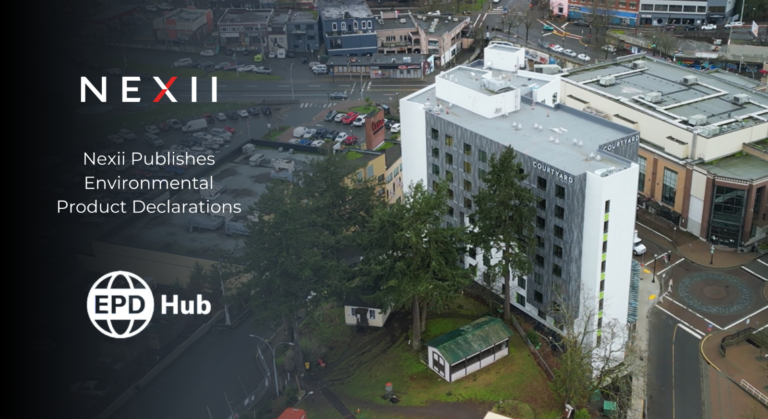
Zosia Brown, PhD, is Nexii’s Vice President, Sustainability. Her notable past roles include Head of Sustainability at Woodland Park Zoo, WA, and Associate with Buro Happold.
Zosia’s PhD in Resource Management Environmental Studies focused on green building performance and post-occupancy evaluation. She brings over 15 years’ experience in driving sustainable change and environmental policy in organizations across North America and Europe to Nexii. Zosia’s deep and consistent focus on product performance, carbon impact of operations, zero waste and climate resilience are at the heart of Nexii’s operations. Together with teams from across the company, Zosia leads Nexii’s environment, social and governance (ESG) strategy underpinning our mission to build a vibrant future for people and planet.
Nexii recently joined the Carbon Leadership Forum (CLF) as a sponsor. The CLF aims to eliminate embodied carbon in buildings and infrastructure by inspiring change and innovation in materials, building and construction industries. We are excited to collaborate with the CLF and other like-minded partners committed to decarbonizing the built environment.
We are in a climate emergency. What we do now as a society will affect the future of our world, the environment, and the lives of our children. Our planet is changing at a remarkable rate, and much of that is due to human activities that emit heat-trapping carbon dioxide into the air and warm our planet. Global warming is escalating the frequency and intensity of extreme weather events we are experiencing and living through today. A prime example is last month’s heatwave that shattered records throughout the Pacific Northwest and created conditions for an intense wildfire season in Western Canada, with a devastating toll on the human and natural world. We feel deeply for the residents of Lytton, B.C., and thousand of families currently on evacuation order or alert as fires continue to burn across the province.
Events like these are redefining our planet as we know it, and focus our attention on the urgency of climate action needed – we need to get to work and we haven’t a moment to lose. As Christiana Figueres, former head of the UN climate change convention, says “this is the decade and we are the generation.”[1] We are at a unique point in our trajectory where we have the capital, technology, the policies and the scientific knowledge to half our emissions by 2030 and get to net-zero by 2050.[2] And the building and construction industry will play a vital role in helping us get there.
Buildings and Construction – Key Players in the Climate Crisis
Buildings and the construction industry are responsible for a staggering 39% of global GHG emissions.[3]Much of this comes down to the materials we use, how we heat, cool and light our buildings, and how we construct, demolish, and generate vast quantities of waste.
Global building-related CO2 emissions have risen by nearly 1% per year since 2010.[4] Moreover, it is projected that the volume of buildings on earth will double in the next 40 years, potentially adding more than 230 billion m2 to the planet in new building construction.[5] This represents a lot of committed emissions. In other words, buildings have staying power – once we build them, they chug away at resources for 50, 75 years or longer. Currently, building renovations affect only 0.5-1% of the building stock annually.[6] If we want to tackle building-related carbon emissions, we need to design new buildings right from the start – to low and clean energy standards, and significantly increase the rate of deep energy retrofits of existing buildings.
Not only do buildings lock in emissions during the use phase, but upfront embodied carbon emissions from harvesting and producing building materials are significant in their own right! Currently embodied carbon emissions are responsible for 1/4th of building sector emissions and that number is growing.[7] Understanding embodied carbon and using tools such as life cycle assessment (LCA) to measure the impact of our buildings and facilitate decisions is key to how the building materials and construction sector can make a difference.
What is Embodied Carbon?
Building embodied carbon is the CO2 emitted during the entire life cycle of a building or a building product. Embodied carbon includes the emissions from the extraction of raw materials, processing and manufacturing of building products, transportation to site, assembly/installation and disposal or reuse of building materials at the end of life.
Life cycle assessment (LCA) allows us to track the emissions across different boundaries – cradle-to-gate, cradle-to-grave or cradle-to-cradle – depending on the information available and project needs. LCA results are converted to metrics such as embodied emissions intensity (kgCO2e/m2) to measure the carbon impact of our product on the environment. 
All stages of a building’s life are considered as part of a full embodied carbon LCA. By comparison, building operational carbon emissions only refers to the CO2 emitted from energy consumption of a building in-use – primarily from heating, cooling, and lighting. Operational carbon emissions can be reduced through energy efficiency upgrades, shifting fossil energy sources to electric, and using renewable energy. Embodied carbon emissions can be reduced through carbon smart material choices and closing the loop on material flows at the end of a building’s life.
In my next blog, I’ll discuss why we urgently need to tackle embodied carbon and what the building materials and construction sector can do to drive decarbonization.
Contact us to find out how Nexii can help your next project reduce carbon emissions at each stage of the planning and construction process.
[1] The Guardian, 2020 Christiana Figueres on the climate emergency
[2] Figueres, C. and Rivett-Carnac, 2020 The Future We Choose
[3] UN Environment Global Status Report 2019; EIA International Energy Outlook 2019
[4] UN, 2017 Towards a zero-emission, efficient, and resilient buildings and construction sector
[5] UN, Time is running out for construction sector to cut energy use, meet climate goals
[6] [7] https://architecture2030.org/buildings_problem_why/




